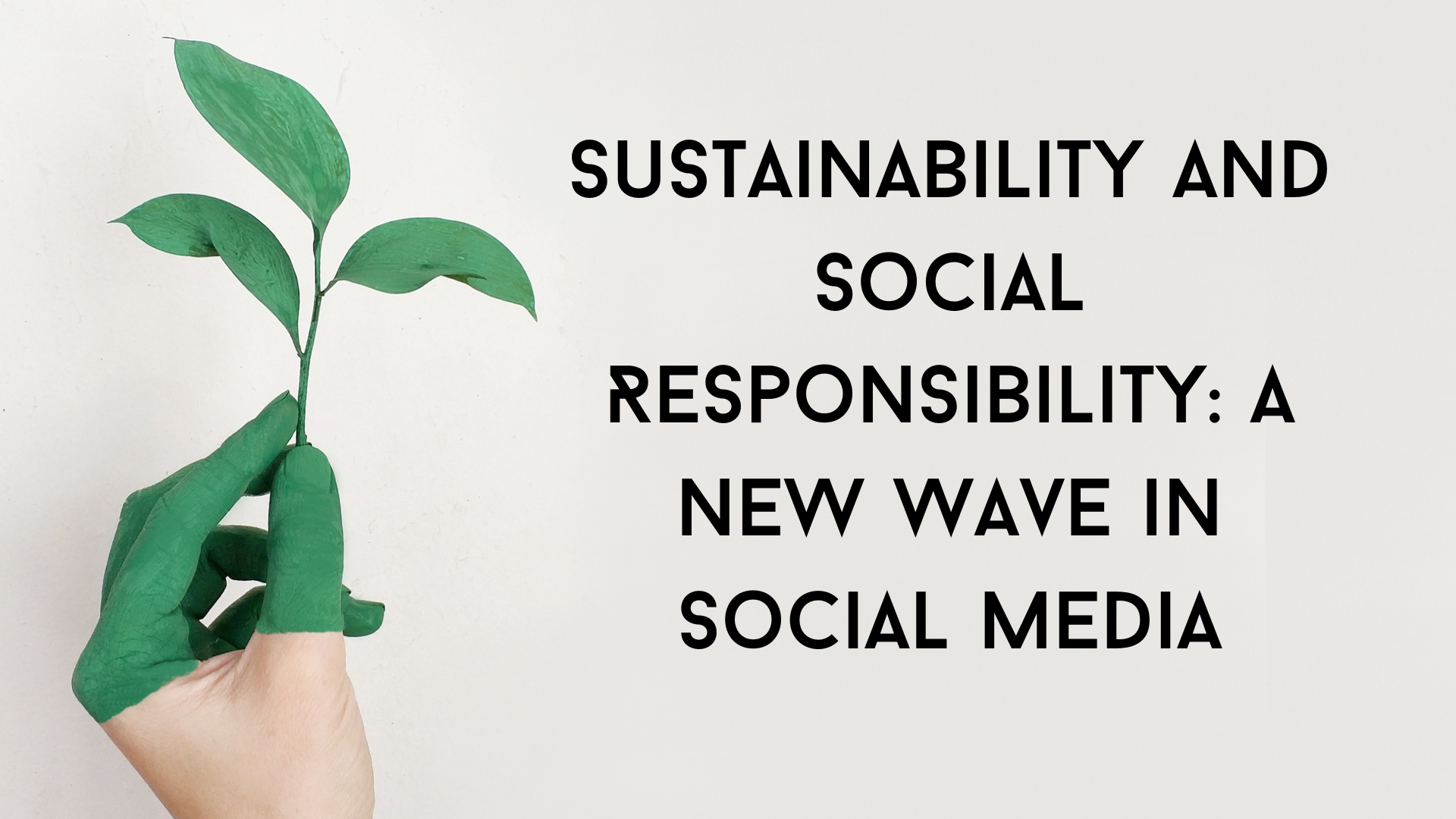It’s no longer just about likes, shares, and hashtags; it’s about making a positive impact on the world. Brands, influencers, and users alike are recognizing the power of social media as a platform for change and are embracing sustainability and social responsibility like never before. In this blog post, we’ll delve into this exciting shift, exploring how social media is becoming a force for good. We’ll discuss the role of sustainability and social responsibility in the digital age, highlighting inspiring examples and sharing actionable insights. Get ready to ride the wave of change as we explore how social media is transforming into a catalyst for a better world.
The Rise of Sustainability and Social Responsibility in Social Media
As we embark on this journey into the world of sustainability and social responsibility in social media, it’s essential to understand the significant shifts that have taken place.
Understanding the Shift Towards Sustainable Values
Sustainability is no longer just a buzzword; it’s a movement. People today are more aware of environmental and social issues and are looking to support brands that align with their values.
- Consumer Demand: Customers, especially younger generations like Gen Z and Millennials, actively seek out sustainable products and ethical practices.
- Environmental Concerns: Growing awareness of climate change and environmental issues has intensified the call for sustainable solutions.
- Social Impact: Social responsibility is equally crucial, with consumers supporting brands that promote fair labor practices and social justice.
The Impact of Gen Z and Millennials
The younger generations are at the forefront of this sustainability revolution.
- Driving Change: Gen Z and Millennials are using their purchasing power to influence brands to adopt sustainable and socially responsible practices.
- Digital Natives: These generations are digital natives, making social media their primary platform for expressing their values and opinions.
- Influence on Older Generations: Their values are also inspiring older generations to become more sustainability-conscious.
Social Media’s Role in Advocating Sustainability
Social media platforms have become powerful advocates for sustainability and social responsibility.
- Amplification: Social media amplifies messages related to sustainability, making them more accessible and shareable.
- Advocacy: Individuals and organizations use social media to advocate for sustainability, driving awareness and change.
- Brand Engagement: Brands that embrace sustainability on social media often see increased engagement and loyalty from their audience.
This shift towards sustainability is not a passing trend. It’s a fundamental change in consumer behavior and expectations, and businesses must adapt to thrive in this new landscape.
Incorporating Sustainability into Your Brand Identity
Now that we understand the importance of sustainability in social media, let’s explore how to weave it into your brand identity.
Defining Your Brand’s Sustainability Values
Before you can effectively communicate your commitment to sustainability, you must first define your brand’s sustainability values:
- Identify Priorities: Determine which environmental and social issues align with your brand’s mission and resonate with your audience.
- Set Clear Goals: Establish specific sustainability goals that your brand aims to achieve, such as reducing carbon emissions or supporting fair labor practices.
- Integrate Values: Ensure that these values become an integral part of your brand’s identity, influencing decision-making and operations.
Defining your sustainability values provides a solid foundation for your brand’s commitment to responsible practices.
Authenticity in Sustainability Messaging
Authenticity is paramount when incorporating sustainability into your brand’s messaging:
- Walk the Talk: Authenticity begins with aligning your brand’s actions with its sustainability values. Implement real changes that reflect your commitment.
- Honesty Matters: Be transparent about your sustainability journey, including both successes and challenges. Authenticity builds trust.
- Avoid Green-washing: Green-washing, or making false or exaggerated sustainability claims, can harm your brand’s reputation. Ensure all messaging is truthful.
Consumers can discern genuine efforts from mere marketing ploys, so authenticity is key to earning their trust.
Crafting a Sustainable Brand Story
Your brand’s sustainability journey is a compelling story waiting to be told:
- Narrative Development: Craft a narrative that communicates your brand’s sustainability values, goals, and actions. Make it relatable and inspiring.
- Visual Storytelling: Use visual content on social media, such as images and videos, to showcase your sustainability initiatives in action.
- User Engagement: Encourage user-generated content that aligns with your brand’s sustainability story. Share customer stories and experiences.
Your sustainability story should resonate with your audience, inspiring them to become part of your brand’s journey toward a more sustainable future.
Incorporating sustainability into your brand identity is not only a responsible choice but also a strategic one. It aligns your brand with the values of your audience and sets you on a path towards long-term success.
Building Sustainable Communities on Social Media
Now, let’s explore how to create and nurture sustainable communities on social media, allowing your brand to connect with like-minded individuals.
Creating and Nurturing Online Sustainability Communities
Building online communities centered around sustainability requires a thoughtful approach:
- Choose the Right Platform: Select social media platforms that align with your target audience’s preferences and values. For sustainability, platforms like Instagram and Twitter often work well.
- Content Strategy: Share informative and inspiring content related to sustainability. Engage with your audience through tips, stories, and educational posts.
- Engagement: Foster discussions and interactions within the community. Respond to comments, ask questions, and encourage members to share their sustainability journeys.
By creating a welcoming space for sustainability enthusiasts, your brand can be at the center of meaningful conversations.
Engaging with Sustainability Advocates
Sustainability advocates can be powerful allies in building your online sustainability community:
- Identify Advocates: Look for individuals or organizations with a strong commitment to sustainability. They can be influencers, activists, or passionate community members.
- Collaborate: Partner with these advocates to co-create content, host events, or drive sustainability initiatives. Their endorsement adds credibility to your brand’s sustainability efforts.
- Amplify Their Voices: Share the content and initiatives of sustainability advocates within your community. This reciprocity builds stronger relationships.
Sustainability advocates not only enrich your community but also extend its reach and impact.
Amplifying User-Generated Sustainability Content
User-generated content (UGC) can be a potent tool for community engagement:
- Encourage UGC: Invite your community members to share their sustainable practices, tips, and stories. Use branded hashtags to track UGC.
- Recognition and Rewards: Showcase user-generated content on your brand’s social media profiles. Acknowledge and reward contributors to foster a sense of belonging.
- Storytelling: Turn UGC into impactful stories that highlight the positive impact of sustainability. Share these stories to inspire others.
Amplifying UGC not only empowers your community members but also showcases your brand as a champion of sustainability.
Building sustainable communities on social media requires ongoing effort and genuine commitment. These communities become platforms for advocating sustainability, driving change, and strengthening your brand’s presence.
Sustainability-Driven Content Strategies
Now, let’s explore effective content strategies that can help your brand promote sustainability and social responsibility on social media.
Crafting Eco-Friendly and Ethical Content
Crafting content that reflects your commitment to sustainability requires attention to eco-friendly and ethical considerations:
- Eco-Friendly Materials: Use eco-conscious materials for visuals and promotional materials. Opt for recycled paper, biodegradable products, and sustainable printing methods.
- Fair Trade and Ethical Practices: Highlight your brand’s ethical sourcing and fair labor practices in your content. Showcase your commitment to social responsibility.
- Sustainability Themes: Integrate sustainability themes into your content, such as reducing waste, conserving resources, and protecting the environment.
Eco-friendly and ethical content not only aligns with your sustainability values but also resonates with conscious consumers.
Storytelling for Sustainability
Effective storytelling can convey the importance of sustainability and social responsibility:
- Narrative Development: Craft compelling stories that illustrate your brand’s sustainability journey, challenges overcome, and positive impacts.
- Visual Storytelling: Use visuals, such as videos and infographics, to tell stories about sustainability initiatives, from sourcing to production to delivery.
- Consumer Engagement: Involve your audience in your sustainability story. Encourage them to share their stories and experiences related to your brand’s values.
Effective storytelling has the power to inspire and engage your audience, fostering a deeper connection to your brand.
howcasing Sustainable Practices and Initiatives
Your content should shine a spotlight on your brand’s sustainable practices and initiatives:
- Behind-the-Scenes: Share behind-the-scenes glimpses of your sustainability efforts, such as eco-friendly packaging processes or renewable energy sources.
- Impact Stories: Highlight the tangible impacts of your sustainability initiatives, whether it’s reducing carbon emissions or supporting local communities.
- Educational Content: Create informative content that educates your audience about sustainability topics, empowering them to make eco-conscious choices.
Showcasing your sustainability practices and initiatives not only builds credibility but also encourages your audience to support your brand’s mission.
With these sustainability-driven content strategies, your brand can effectively communicate its commitment to a more sustainable and socially responsible future.
Measuring the Impact of Sustainability Campaigns
Let’s delve into how you can measure the effectiveness and impact of your sustainability campaigns on social media.
Key Performance Indicators (KPIs) for Sustainability Marketing
To assess the success of your sustainability marketing efforts, consider these KPIs:
- Social Engagement: Measure likes, shares, comments, and other interactions on your sustainability-related content.
- Website Traffic: Track the increase in website visits resulting from sustainability-focused social media campaigns.
- Conversion Rates: Monitor the conversion of social media leads into customers, especially those driven by your sustainability initiatives.
These KPIs help gauge the effectiveness of your sustainability marketing efforts in engaging and converting your audience.
Analyzing the Environmental and Social Impact
Beyond traditional metrics, assessing the environmental and social impact is crucial:
- Carbon Footprint Reduction: Measure the reduction in carbon emissions resulting from sustainability initiatives, such as reduced energy consumption or transportation emissions.
- Community Involvement: Assess the involvement of local communities and social organizations in your sustainability projects.
- Positive Social Outcomes: Analyze the social benefits, such as job creation or improved living conditions, brought about by your sustainability efforts.
These metrics provide a holistic view of how your sustainability campaigns contribute to a better world.
Adapting Strategies Based on Sustainability Metrics
Regularly review your sustainability metrics to refine your strategies:
- Continuous Improvement: Identify areas where your sustainability campaigns can be more effective and make necessary adjustments.
- Responsive Action: Be proactive in addressing any negative environmental or social impacts that may arise.
- Transparent Reporting: Share your sustainability metrics and progress with your audience to maintain transparency and accountability.
Adapting your strategies based on sustainability metrics ensures that your efforts align with your goals and contribute positively to the planet and society.
Measuring the impact of sustainability campaigns is an essential step in demonstrating your commitment and fostering trust with your audience.
Navigating Ethical and Greenwashing Concerns
Let’s delve into how your brand can navigate ethical considerations and avoid greenwashing pitfalls while promoting sustainability on social media.
Ensuring Ethical Sourcing and Practices
To maintain your brand’s ethical reputation:
- Sustainable Sourcing: Ensure that your sourcing practices align with sustainable and ethical standards, from raw materials to production.
- Fair Labor Practices: Uphold fair labor practices and safe working conditions for all employees and partners in your supply chain.
- Third-Party Certification: Seek certifications or endorsements from credible third-party organizations that validate your ethical practices.
Ethical sourcing and practices are the foundation of genuine sustainability efforts.
Avoiding Greenwashing Pitfalls
Be cautious not to fall into the greenwashing trap:
- Transparent Claims: Ensure that your sustainability claims are accurate and supported by evidence. Avoid exaggerations or false statements.
- Clear Communication: Clearly communicate your sustainability initiatives, their scope, and their real-world impacts to avoid misleading your audience.
- Independent Verification: Seek independent verification of your sustainability efforts to build trust with your audience.
Authenticity in your sustainability messaging is essential to maintaining credibility.
Demonstrating Transparency and Accountability
Demonstrate your commitment to transparency and accountability:
- Regular Reporting: Share regular updates on your sustainability journey, including both successes and challenges.
- Listening and Feedback: Actively listen to your audience’s concerns and feedback regarding your sustainability practices, and address them transparently.
- Collaboration and Partnerships: Collaborate with sustainability organizations, NGOs, or industry watchdogs to showcase your dedication to ethical and sustainable practices.
Transparency and accountability reassure your audience that your brand’s sustainability efforts are genuine and continuously improving.
Navigating ethical considerations and avoiding greenwashing pitfalls is essential to maintain your brand’s reputation and credibility while championing sustainability.
The Future of Sustainable Social Media Marketing
Let’s take a glimpse into the future of sustainable social media marketing and how it will shape the digital landscape.
Predicting Trends in Sustainable Marketing
Staying ahead of the curve in sustainable marketing involves predicting upcoming trends:
- Climate Positivity: Anticipate the shift towards climate-positive marketing, where brands actively remove more carbon emissions from the environment than they produce.
- Regenerative Practices: Explore regenerative marketing, which focuses on restoring ecosystems and communities, contributing to a more sustainable world.
- Blockchain Transparency: Embrace blockchain technology for transparent supply chains, allowing consumers to trace the origins of products.
By predicting and adopting these trends, your brand can remain at the forefront of sustainable marketing.
Innovations in Sustainable Social Media Practices
The future of sustainable marketing will witness innovative practices in social media:
- Virtual Sustainability Experiences: Create immersive virtual experiences that allow consumers to engage with your sustainability initiatives firsthand.
- AI-Driven Sustainability: Leverage artificial intelligence to personalize sustainability recommendations and eco-conscious content for individual users.
- Social Impact Metrics: Develop new metrics that measure the social impact of your sustainability efforts, going beyond traditional analytics.
Embracing these innovations can help your brand connect with a socially conscious audience.
Sustainability as a Competitive Advantage
Sustainability will increasingly become a competitive advantage in the marketing landscape:
- Consumer Expectations: Recognize that consumers will expect sustainability from brands, making it a key factor in their purchasing decisions.
- Brand Loyalty: Cultivate brand loyalty by consistently demonstrating your commitment to sustainability and social responsibility.
- Market Differentiation: Use sustainability as a unique selling point, setting your brand apart in a crowded market.
The future will see sustainability not just as a choice but as a necessity for brands to thrive in the social media marketing arena.
The future of sustainable social media marketing is dynamic, driven by innovation, and increasingly vital for brand success in a conscious consumer landscape.
In conclusion, sustainability and social responsibility are ushering in a new era in social media—one where making a positive impact is just as important as gaining followers. As we’ve seen, brands, influencers, and users are using their online presence to advocate for a better world, and this movement is only gaining momentum. Whether it’s promoting eco-friendly products, supporting social causes, or advocating for ethical practices, social media is proving to be a powerful tool for change. So, as you navigate the digital landscape, consider how you can contribute to this new wave of sustainability and social responsibility. By aligning your online presence with meaningful causes, you can not only connect with your audience on a deeper level but also play a part in creating a more sustainable and socially responsible future through the far-reaching impact of social media.



